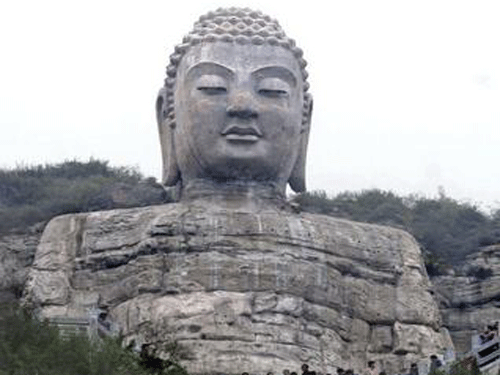Trove of Buddhist relics found in Midnapore
Last Updated IST

The site, currently a buzz of activities, has led to the discovery of some 50 relics connected to Buddhism, which was widely practiced in eastern Indian between seventh and 12th Century. Reuters file photo for representation only
Fourteen years after archaeologists stumbled upon the nondescript mound at Moghalmari in West Midnapore district, the site has thrown up one of the largest finds of Buddhist history in India.
The site, currently a buzz of activities, has led to the discovery of some 50 relics connected to Buddhism, which was widely practiced in eastern Indian between seventh and 12th Century.
While archeologists from Calcutta University first came across this site in March 2001, the state archaeology department has since taken charge. On January 23 this year they came across around 40 bronze artifacts dating back to fifth and sixth century. Since then, diggers have come across more relics, with chances that digging deeper will lead to further finds.
In 2001, archaeologists first found the structural details of a monastery, an inscribed seal and a broken bust, believed to be of the Buddha. While Moghalmari village, around 180 km from Kolkata, became an important find in understanding history of Buddhism in India, particularly Bengal, the dig emerged a centre of attention since January 23, with archeologists believing the site will provide crucial insights in assessing and understanding spread of Buddhism to eastern India and eventually to other parts of Asia.
Archaeologists involved with the project pointed out that the seal found in 2001 carries an inscription in Sanskrit, which when deciphered, turned out to be the Buddhist Dharmaparyay, a hymn with the message of the Buddha’s teachings on philosophy. Besides the seal that dates back to eighth century, archaeologists also found terracotta tablets. The primary image on them is of the Buddha in meditation, with two rows of miniature figures in the bottom, depicting the five famous transcendent Buddhas.
Asok Datta from Calcutta University, who led the first excavation team, believes the tablets are a clincher in proving the site’s monastic identity.
“The tablets prove the existence of an extensive monastic settlement at the site,” he said. After the initial find in 2001, the mound was first excavated by Calcutta University’s archaeology department between 2003 and 2004 but it took them around two years to substantially establish the site’s monastic identity.
The finds on January 23 include a range of bronze figurines, mostly of the Buddha but some of Saraswati and Avalokiteshwara, with the tallest being around 25 cm and the smallest, seven cm high.
The site, currently a buzz of activities, has led to the discovery of some 50 relics connected to Buddhism, which was widely practiced in eastern Indian between seventh and 12th Century.
While archeologists from Calcutta University first came across this site in March 2001, the state archaeology department has since taken charge. On January 23 this year they came across around 40 bronze artifacts dating back to fifth and sixth century. Since then, diggers have come across more relics, with chances that digging deeper will lead to further finds.
In 2001, archaeologists first found the structural details of a monastery, an inscribed seal and a broken bust, believed to be of the Buddha. While Moghalmari village, around 180 km from Kolkata, became an important find in understanding history of Buddhism in India, particularly Bengal, the dig emerged a centre of attention since January 23, with archeologists believing the site will provide crucial insights in assessing and understanding spread of Buddhism to eastern India and eventually to other parts of Asia.
Archaeologists involved with the project pointed out that the seal found in 2001 carries an inscription in Sanskrit, which when deciphered, turned out to be the Buddhist Dharmaparyay, a hymn with the message of the Buddha’s teachings on philosophy. Besides the seal that dates back to eighth century, archaeologists also found terracotta tablets. The primary image on them is of the Buddha in meditation, with two rows of miniature figures in the bottom, depicting the five famous transcendent Buddhas.
Asok Datta from Calcutta University, who led the first excavation team, believes the tablets are a clincher in proving the site’s monastic identity.
“The tablets prove the existence of an extensive monastic settlement at the site,” he said. After the initial find in 2001, the mound was first excavated by Calcutta University’s archaeology department between 2003 and 2004 but it took them around two years to substantially establish the site’s monastic identity.
The finds on January 23 include a range of bronze figurines, mostly of the Buddha but some of Saraswati and Avalokiteshwara, with the tallest being around 25 cm and the smallest, seven cm high.